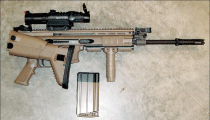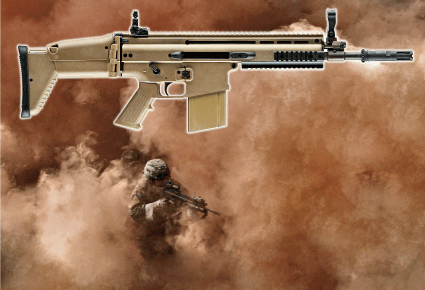The importance of SOCOM units in the War on Terror has given them a lot more clout in weapons that are designed to enhance the special operator. The ongoing process of selecting a new pistol for special ops forces is one example of this interest in spec ops weapons, but the development of the Special Operations Forces Combat Assault Rifle (SCAR) is an even better example.
 The Special Operations Forces Combat Assault Rifle (SCAR) is a modular assault rifle system designed by FNH USA, which meets a September 2003 SOCOM requirement. Even though the initial testing program was intended to be a two-phase process, FNH was awarded the contract at the end of Phase One, since they were the only one to meet all of the requirements. The SOCOM development contract was awarded to FNH in late 2004, and the modular assault rifle system is now in “Low Rate Initial Production,” which allows FNH to iron out production problems as encountered and to produce enough weapons for testing.
The Special Operations Forces Combat Assault Rifle (SCAR) is a modular assault rifle system designed by FNH USA, which meets a September 2003 SOCOM requirement. Even though the initial testing program was intended to be a two-phase process, FNH was awarded the contract at the end of Phase One, since they were the only one to meet all of the requirements. The SOCOM development contract was awarded to FNH in late 2004, and the modular assault rifle system is now in “Low Rate Initial Production,” which allows FNH to iron out production problems as encountered and to produce enough weapons for testing.
Gun Details
There are two versions of the SCAR, the SCAR-L (Light), chambered in 5.56mm and SCAR-H (Heavy), chambered in 7.62mm, the actual military designations are MK 16 Mod 0 (SCAR-L) and MK 17 Mod 0 (SCAR-H). The “MK,” a naval prefix, is used because the rifles are being tested for SOCOM at Crane Naval Weapons Support/Naval Surface Warfare Center.
Advertisement — Continue Reading Below
Although the primary round for the SCAR-H is the 7.62x51mm NATO round, they could be chambered in 7.62x39mm. I have also heard mentions of SCARs in 6.8mm. SCARs are also designed to be compatible with the Enhanced Grenade Launcher Module (EGLM) and to be fired with programmable ammunition.
The SCAR system can accommodate different barrel lengths as well as a wide variety of calibers to adapt to various missions. The SCAR-L and SCAR-H share 83 percent of the same parts, which helps shorten SOCOM’s logistic tail. The plan is that the SCAR-L will replace the M4A1, MK 18, and MK 12 SPR, while the SCAR-H will replace the M14 and MK 11 sniper rifles, while adding a new capability with the SCAR-H CQC version. The EGLM is designed to replace the M203 and still use the M79 grenade launcher.
The anticipated production of the SCAR-L is around 125,000 and of the SCAR-H around 35,000. Of that total, around two-thirds will be the 14-inch SCAR-L (Standard) models. Of course, the system is modular so configuration may be readily changed. One interesting aspect of projected SCAR-H production, it’s anticipated that fewer than 3,000 models will be ordered in 7.62x39mm.
Advertisement — Continue Reading Below
I’ve mentioned barrel lengths so let me clarify the three lengths available for each. For SCAR-L, barrel lengths are 10 inches for the CQC model, 14 inches for the Standard model, and 18 inches for the Long Barrel model. For the SCAR-H, barrel lengths are 13 inches for the CQC model, 16 inches for the Standard model, and 20 inches for the Long Barrel. Anticipated production for the SCAR-L and SCAR-H Long Barrel is almost identical at fewer than 12,000 units each.
The SCAR uses a true short stroke, tappet-style closed gas system familiar to most shooters of the M1 carbine. SOCOM requirements stressed reliability with the requirement set at three times the reliability of the M4. The SCAR is exceptionally ergonomic and readily maintainable. A good example of the ergonomic design is the location of the charging handle. It is made for easy use by the support hand, without having to remove the other hand from the pistol grip. By the way, at SOCOM’s request, the pistol grip is one part that remains very similar to that on the M4.
The SCAR has multiple MIL-STD 1913 rails. The long top rail allows the attachment of a combination of optical sights and night vision equipment. Excellent flip-up front and rear sights offer engagement capability should optics go down. Additional side and bottom rails allow the attachment of a pistol grip and/or various types of illuminators. The lower rail is designed to be especially durable to handle the recoil of the EGLM.
Advertisement — Continue Reading Below
Other features include a flared magazine well, and an ergonomic stock in a desert tan finish. The SCAR is highly corrosion resistant and will function without lube for a limited time. I was especially impressed with the stock. Though a folding stock, it feels solid and comfortable like a fixed stock, and it also telescopes, to six positions, like a M4 stock to allow different-sized operators and the use of body armor. The desert tan finish allows the weapon to blend in with a camouflaged uniform and surroundings in the daytime and offers less IR (infrared) signature than a black rifle at night.
Despite all of its features, the SCAR is surprisingly light, weighing 6.8 pounds unloaded for the SCAR-L and 7.2 pounds unloaded for the SCAR-H. The magazine capacity for the SCAR-L is either 20 or 30 rounds and for the SCAR-H either 10 or 20 rounds. With the 20-round magazine in place, it is possible to easily go for the SCAR-H LB variant. Because the SCAR is relatively light, the fact that the cyclic rate is on full auto, kept to 550 rounds per minute (rpm), is definitely a plus especially with the SCAR-H.
The SCAR is designed to improve accuracy over the M4 and to stretch its effective range by an additional 100 to 200 meters. The threshold was to achieve a 70 percent hit ratio on a 500-meter point target and 600-meter area target with the SCAR-L and 70 percent on a 600-meter point target and 800-meter area target with the SCAR-H. I only had a chance to shoot both the SCAR-L and SCAR-H at 200 meters hitting a steel plate, about the size of an enemy’s head, readily at that range. The SCAR can also be configured to work with a specific suppressor to meet SOCOM mission needs.
Advertisement — Continue Reading Below
Take a look at this article about 15 iconic select-fire guns.
Range Time
I was definitely impressed with the SCAR’s handling and shooting characteristics. The test guns I fired were equipped with a Leupold Mark IV MR/T 1.5-5x20mm scope that allowed me to easily identify and engage targets. Ergonomics as specified by SOCOM are excellent and allowed easy bolt operation with the support hand, including locking it to the rear, and ease of magazine changes. As I stated previously, I was particularly impressed with the stock.
Shooting off the bench and off-hand, the stock was comfortable. I found the SCAR’s flash suppressor particularly useful when firing the SCAR-H off the bench and under cover. I did not get a chance to shoot the CQC version of the SCAR-H, but I’m sure I would have wanted flash suppression capability as much as possible. Offhand, the SCAR-H 7.62mm was lively in the hands.
Advertisement — Continue Reading Below
I got a chance to shoot both a SCAR-L and SCAR-H, both equipped with a front pistol grip. I don’t always like this accessory, but because of the way the bolt cycles on the support side, it was useful keeping the hand away from the bolt. I got my chance to shoot the SCAR at an FNH range day for writers.
Lots of FNH handguns and rifles were there to shoot, but I have to admit that I was so impressed with the SCAR that I kept sneaking back to shoot one or another version every time that position was open. In fact, I decided to forego shooting other interesting weapons to get more time on the SCAR.
Final Notes
Sometimes, I think new requirements for military weapons, especially in the special ops community, occur because the operators are “high speed” guys who do a lot of shooting and want an equally high speed weapons system that is different from everyone else. Well, there is no doubt that the SCAR is a “high speed” weapons system, and it is definitely one that was created to help the special operators perform their missions effectively.
Advertisement — Continue Reading Below
Based on my limited handling and shooting with the SCAR-L and SCAR-H, I think this is a great weapons system, one that can be tailored to just about any special ops mission or conventional missions for that matter. SOCOM and FNH got it right on this one. The best news is that our special operations personnel will be getting an effective and user-friendly system. But close behind that is the news that FNH plans to market a semi-auto civilian version of the SCAR tentatively in the near future!
Check out this article about the FN Military Collector Series: Three Frontline Legends
Advertisement — Continue Reading Below























